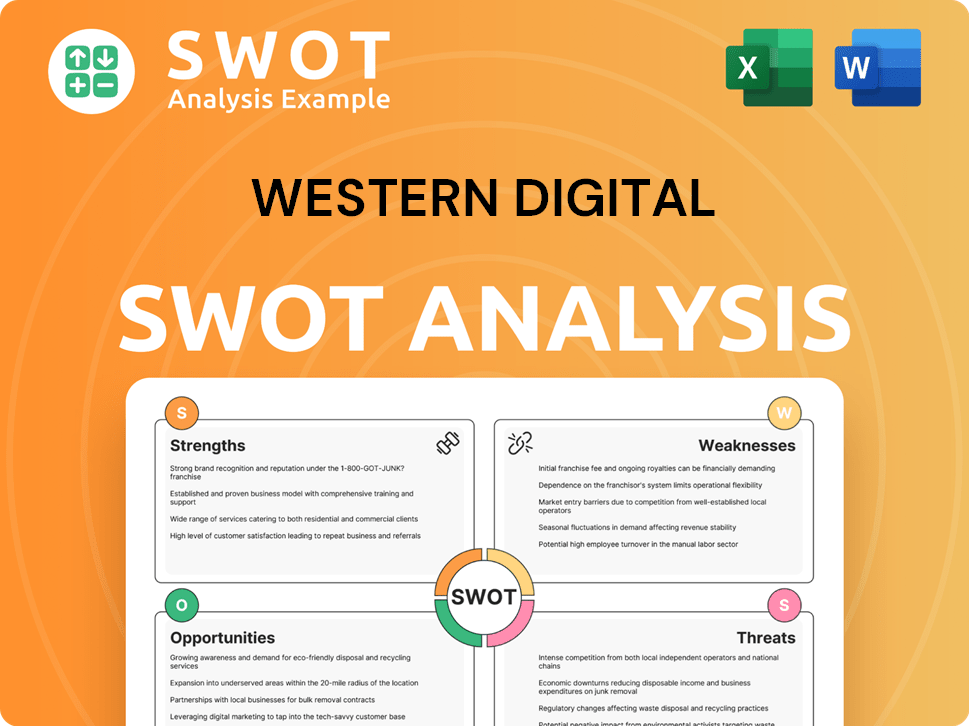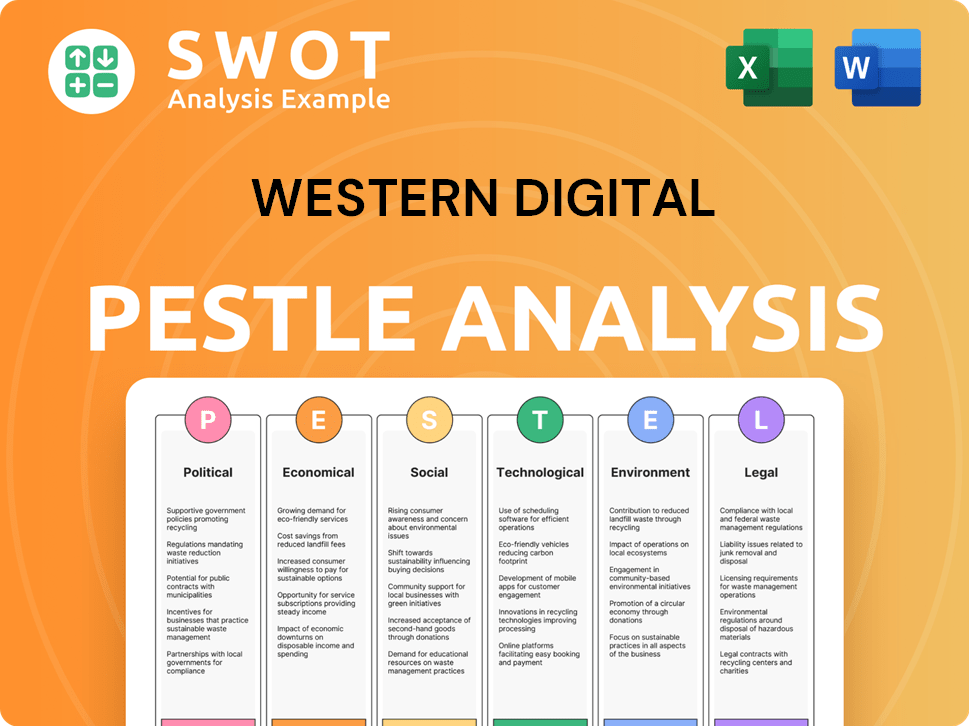Western Digital Bundle
How is Western Digital Reshaping Its Sales and Marketing in the Data Age?
Western Digital, a titan in data storage, recently spun off its Flash business, signaling a bold strategic shift. This move allows the company to concentrate on its core strength: high-capacity Hard Disk Drives (HDDs) tailored for the cloud and enterprise sectors. Understanding the evolution of Western Digital's Western Digital SWOT Analysis is key to grasping its future.

This strategic pivot demands a deep dive into Western Digital's sales strategy and marketing strategy, especially considering the surging demand for data storage solutions. We'll explore the company's sales channels, marketing tactics, brand positioning, and key campaigns. Analyzing WD sales and marketing strategies provides insights into how Western Digital navigates a competitive landscape, focusing on enterprise and cloud storage to drive growth.
How Does Western Digital Reach Its Customers?
The sales channels of Western Digital (WD) are designed to reach a broad customer base, utilizing a mix of both online and offline strategies. Historically, WD has used direct sales teams, wholesale distributors, and partner retailers to engage with its customers. However, with the rise of digital commerce, e-commerce platforms and the company's website have become increasingly important for reaching consumers and smaller businesses. This multifaceted approach is a key component of its overall sales strategy.
A significant shift in Western Digital's sales strategy involves a greater focus on high-capacity enterprise drives and data center solutions. This strategic direction is particularly evident following the spin-off of its Flash business in early 2025. WD is now emphasizing direct engagement with major hyperscalers, cloud service providers, and original equipment manufacturers (OEMs). This change reflects an adaptation to the evolving data storage market and the growing demand for cloud-based solutions.
In fiscal Q3 2025, the cloud segment generated 87% of Western Digital's total revenue, underscoring the importance of this channel. The company's emphasis on nearline HDDs for cloud and hyperscale customers is a key driver of its HDD business growth. While consumer products remain part of the portfolio, the primary strategic focus has shifted towards the enterprise and cloud segments, demonstrating the company's ability to adapt to market changes.
WD utilizes direct sales teams to engage with key enterprise clients, hyperscalers, and OEMs. These teams focus on building relationships and providing tailored solutions. This approach allows for a more personalized service and better understanding of customer needs, which is crucial for high-value contracts and strategic partnerships.
Wholesale distributors play a vital role in WD's sales strategy, especially in reaching a wide range of customers. These distributors manage the distribution of products to various retailers and resellers. This channel helps WD to efficiently manage its supply chain and extend its market reach.
WD partners with various retailers, both online and offline, to make its products accessible to consumers. These partnerships include major electronics stores and online marketplaces. This channel provides a broad reach to consumers and allows WD to leverage the marketing efforts of its retail partners.
E-commerce platforms and WD's own website are crucial for direct-to-consumer sales and reaching smaller businesses. These platforms offer convenience and a wide selection of products. WD uses these channels to provide detailed product information and special promotions, enhancing customer engagement.
The primary focus of WD's sales strategy is shifting towards enterprise and cloud segments, with a strong emphasis on direct engagement with major cloud providers. This strategic change is driven by the increasing demand for data storage solutions in the cloud. WD is adapting its sales channels to meet the needs of this growing market.
- Cloud Revenue Dominance: Cloud revenue accounted for 87% of total revenue in fiscal Q3 2025.
- Enterprise Focus: Direct sales efforts are concentrated on hyperscalers, cloud service providers, and OEMs.
- Product Adaptation: The company is focusing on nearline HDDs for cloud and hyperscale customers.
- Consumer Products: WD continues to offer consumer products, but the strategic emphasis is on enterprise and cloud.
Western Digital SWOT Analysis
- Complete SWOT Breakdown
- Fully Customizable
- Editable in Excel & Word
- Professional Formatting
- Investor-Ready Format

What Marketing Tactics Does Western Digital Use?
The marketing tactics employed by Western Digital (WD) are designed to boost brand awareness, generate leads, and drive sales, with a strong emphasis on digital strategies. This approach aligns with its shift towards cloud and enterprise solutions. WD uses a variety of methods, including content marketing, search engine optimization (SEO), and participation in industry events.
Content marketing is crucial for WD, providing detailed information about its advanced storage technologies. This includes products like the 32TB UltraSMR drives and 26TB CMR HDDs, which are designed to meet the growing demands of AI data. SEO is also vital to ensure these specialized products are easily found in technical and enterprise-focused searches. WD's presence at events like the Future of Memory and Storage Conference 2024 (FMS 2024) and CES 2025 serves as a platform to unveil new solutions and engage with key stakeholders.
WD focuses on data-driven marketing and customer segmentation, especially targeting cloud and enterprise clients. It tailors its product development and messaging to meet their specific needs for large capacity, high quality, and low total cost of ownership. This strategic direction supports its sales strategy. The company's marketing efforts are informed by internal projections that estimate a 23% annual growth rate in HDD exabyte shipments from 2024 to 2028, largely driven by AI adoption. This growth influences the company's marketing mix, with communications highlighting the role of HDDs in the AI data cycle and supporting the exponential growth of global data. Learn more about the Target Market of Western Digital.
WD uses content marketing to offer in-depth information about its advanced storage technologies, like 32TB UltraSMR drives and 26TB CMR HDDs. This helps in educating customers and showcasing the benefits of their products, which is a key part of their marketing strategy.
SEO is a vital part of WD's marketing strategy, ensuring that their specialized products are easily found in technical and enterprise-focused searches. This helps in increasing visibility for their products and driving traffic to their website.
WD participates in industry events such as the Future of Memory and Storage Conference 2024 (FMS 2024) and CES 2025. These events serve as a platform to unveil new solutions and engage with key stakeholders, supporting their sales and marketing efforts.
WD uses data-driven marketing to focus on cloud and enterprise clients. This involves tailoring product development and messaging to meet specific needs, which is a key element of their WD sales and marketing approach.
WD segments its customers, especially targeting cloud and enterprise clients. This approach allows them to customize their offerings and communications, which is crucial for their Western Digital sales strategy.
WD anticipates a 23% annual growth rate in HDD exabyte shipments from 2024 to 2028, driven by AI adoption. This projection directly influences their marketing efforts and product development, supporting their WD sales and marketing goals.
WD's marketing strategy includes various tactics aimed at increasing market share and driving sales. These tactics are designed to reach different customer segments and promote their products effectively.
- Content marketing to provide detailed information about products.
- SEO to improve visibility in search results.
- Participation in industry events to showcase new solutions.
- Data-driven marketing to target specific customer needs.
- Customer segmentation to tailor product development and messaging.
Western Digital PESTLE Analysis
- Covers All 6 PESTLE Categories
- No Research Needed – Save Hours of Work
- Built by Experts, Trusted by Consultants
- Instant Download, Ready to Use
- 100% Editable, Fully Customizable

How Is Western Digital Positioned in the Market?
The brand positioning of Western Digital (WD) centers on its role as a leader in high-capacity data storage solutions. This is particularly true for the cloud and enterprise markets, where the demand for data storage is ever-growing. WD differentiates itself through innovation, reliability, and cost-efficiency, aiming to meet the massive data storage needs of its customers. Its core message revolves around unlocking the potential of data, enabling the world to achieve its aspirations through advancements in memory technologies.
WD's visual identity and tone of voice likely reflect a professional, technologically advanced, and trustworthy brand image. The company focuses on its unique selling proposition (USP) of consistently delivering massive capacity, high quality, and low total cost of ownership to its target audience. This includes hyperscale cloud providers, enterprise data centers, and content professionals. WD also emphasizes its commitment to ethical business practices, which enhances its brand perception.
The company maintains brand consistency across various channels, from investor communications to product announcements, reinforcing its strategic focus on HDDs and cloud infrastructure. WD actively responds to shifts in consumer sentiment and competitive threats, as seen by the spin-off of its Flash business. This strategic move allows WD to concentrate on the growing demand for high-capacity HDDs, demonstrating its adaptability in the dynamic data storage market. Understanding the Competitors Landscape of Western Digital is crucial for WD's strategic positioning.
WD's sales strategy emphasizes building strong relationships with key clients, including cloud providers and data centers. It focuses on providing high-capacity, reliable, and cost-effective storage solutions tailored to specific customer needs. WD leverages its extensive distribution network to ensure product availability and support.
The marketing strategy for WD highlights its technological leadership and commitment to innovation. The company uses digital marketing, content marketing, and social media to reach its target audience. WD's marketing campaigns focus on the value proposition of its products, emphasizing performance, capacity, and reliability.
WD's sales are driven by the growing demand for data storage in cloud computing, enterprise data centers, and consumer electronics. The company's sales performance is closely tied to the overall growth of the data storage market. WD's sales teams focus on securing long-term contracts and expanding its customer base.
WD's marketing efforts aim to increase brand awareness and drive demand for its products. The company uses a mix of online and offline marketing channels to reach its target audience. WD's marketing campaigns highlight the benefits of its storage solutions, such as high capacity, performance, and reliability.
In 2024-2025, WD's sales and marketing strategies are shaped by the increasing demand for data storage solutions. The company is focusing on high-capacity HDDs and SSDs for cloud, enterprise, and consumer markets. Key strategies include:
- Focusing on high-capacity HDDs for cloud and enterprise data centers.
- Expanding SSD offerings, particularly in the enterprise and consumer segments.
- Investing in digital marketing and content creation to enhance brand visibility.
- Strengthening partnerships with cloud providers and system integrators.
- Improving supply chain management to meet customer demand.
Western Digital Business Model Canvas
- Complete 9-Block Business Model Canvas
- Effortlessly Communicate Your Business Strategy
- Investor-Ready BMC Format
- 100% Editable and Customizable
- Clear and Structured Layout

What Are Western Digital’s Most Notable Campaigns?
The sales and marketing strategy of Western Digital is not defined by specific, named campaigns in the way some consumer-facing brands might operate. Instead, its approach is characterized by strategic product launches and market positioning, heavily influenced by the evolving data storage landscape. A key focus is on the HDD business, particularly catering to cloud infrastructure and high-capacity drives for AI applications. This strategic shift is a core element of their sales strategy, designed to capitalize on growing data storage demands driven by AI and cloud computing.
Product announcements and participation in industry events serve as significant marketing efforts. Western Digital leverages these platforms to showcase its latest innovations and technologies. These events function as primary channels for product launches and industry engagement, aiming to boost visibility and credibility. The overarching lesson from these initiatives highlights the company's commitment to aligning its offerings with market demands, especially the exponential growth in data driven by AI.
The company's marketing strategy is also influenced by the need to maintain a competitive edge. Owners & Shareholders of Western Digital should be aware of the company's efforts to adapt to market changes. This includes aligning product offerings with the demands of AI and cloud computing. This involves strategic investments in key areas to ensure the company remains competitive in the data storage market.
Western Digital prioritizes its HDD business, especially for cloud infrastructure. This strategic focus is evident in financial reports, with cloud revenue representing a significant portion of total revenue. The company aims to meet the increasing demand for data storage driven by AI and cloud computing.
The company uses industry events to unveil new products and technologies. This includes showcasing innovations like new eSSDs and high-capacity HDDs. These events are crucial for product launches and industry engagement, enhancing visibility and credibility.
Western Digital targets both data centers and consumer segments with its product offerings. This includes solutions for data centers and portable HDDs and SSDs for consumers and content creators. The focus is on meeting diverse storage needs.
The company aligns its offerings with market demands, particularly the growth in data driven by AI. This involves adapting to the evolving storage landscape and meeting the needs of key sectors. The goal is to maintain a competitive advantage.
Western Digital’s sales strategy focuses on the cloud infrastructure and high-capacity drives for AI workloads. Product launches and industry event participation are significant marketing efforts.
- Cloud revenue represented 87% of total revenue in Q3 FY25, growing 38% year-over-year.
- HDD exabyte shipments are projected to grow at a 23% CAGR from 2024 to 2028.
- New solutions and technology demonstrations were showcased at FMS 2024.
- GITEX Africa 2024 featured high-capacity portable HDDs and external SSDs.
Western Digital Porter's Five Forces Analysis
- Covers All 5 Competitive Forces in Detail
- Structured for Consultants, Students, and Founders
- 100% Editable in Microsoft Word & Excel
- Instant Digital Download – Use Immediately
- Compatible with Mac & PC – Fully Unlocked

Related Blogs
- What are Mission Vision & Core Values of Western Digital Company?
- What is Competitive Landscape of Western Digital Company?
- What is Growth Strategy and Future Prospects of Western Digital Company?
- How Does Western Digital Company Work?
- What is Brief History of Western Digital Company?
- Who Owns Western Digital Company?
- What is Customer Demographics and Target Market of Western Digital Company?
Disclaimer
All information, articles, and product details provided on this website are for general informational and educational purposes only. We do not claim any ownership over, nor do we intend to infringe upon, any trademarks, copyrights, logos, brand names, or other intellectual property mentioned or depicted on this site. Such intellectual property remains the property of its respective owners, and any references here are made solely for identification or informational purposes, without implying any affiliation, endorsement, or partnership.
We make no representations or warranties, express or implied, regarding the accuracy, completeness, or suitability of any content or products presented. Nothing on this website should be construed as legal, tax, investment, financial, medical, or other professional advice. In addition, no part of this site—including articles or product references—constitutes a solicitation, recommendation, endorsement, advertisement, or offer to buy or sell any securities, franchises, or other financial instruments, particularly in jurisdictions where such activity would be unlawful.
All content is of a general nature and may not address the specific circumstances of any individual or entity. It is not a substitute for professional advice or services. Any actions you take based on the information provided here are strictly at your own risk. You accept full responsibility for any decisions or outcomes arising from your use of this website and agree to release us from any liability in connection with your use of, or reliance upon, the content or products found herein.